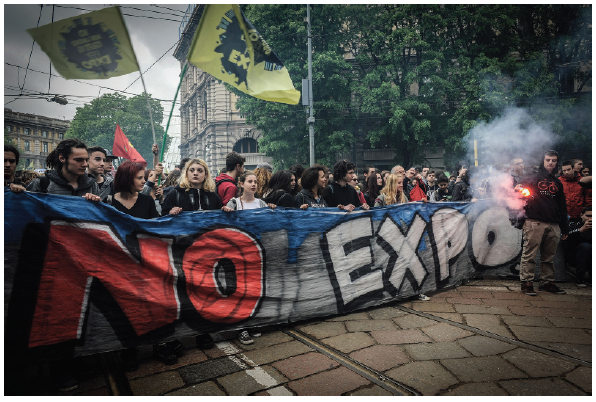1. Do you agree with Slow Foods objections about McDonalds sponsorship participation in Milan Expo 2015? 2....
Question:
2. Do you think Milan Expo 2015 will be a €œgame changer€ that has an impact on problems such as global hunger and sustainable food supplies?
3. Do you think the corporate and national pavilions at Milan Expo 2015 represent money well spent in terms of return on investment?
Not surprisingly, an event with the size and scale of Milan Expo drew its share of criticism. For example, on April 30, the day before Expo opened, thousands of protesters took to the streets in Milan (see Exhibit 14-13). Some of the anger was directed at cost overruns; the Italian pavilion itself was more than ‚¬30 million ($33 million) over budget. The protesters€™ ire was also aimed at a corruption scandal that involved the event€™s manager and several politicians who were accused of accepting bribes in exchange for contracts. Antiglobalization activists were also present: Many viewed the Expo as an example of capitalist excess and accused the organizers of skirting pressing issues such as global hunger.
Other activists focused on the issue of sponsorships. For example, the Slow Food movement was founded in Northern Italy. As noted on the group€™s Web site (www.slowfood.com), Slow Food officials objected to McDonald€™s sponsorship presence at the event. The fast-food giant€™s participation included both a restaurant and a terrace with seating for several hundred people. Also, in conjunction with Italy€™s Ministry of Agriculture, McDonald€™s launched a project called Making the Future. The project offered 20 Italian farmers under the age of 40 the opportunity to become McDonald€™s suppliers. According to Slow Food€™s statement, €œThe presence of McDonald€™s means that the planet can continue to gorge itself on fast food or junk food call it whatever you like€”without concern for our own well-being.€
Despite its anticorporate stance, Slow Food was also an exhibitor at the Expo. Acclaimed Swiss architects Herzog & de Meuron created a special pavilion that took the form of a three-part wooden cascina (farmhouse) typical of Italy€™s Lombardy region. Visitors had the opportunity to taste a variety of artisanal cheeses at an area dubbed, not surprisingly, Slow Cheese. Slow Food officials hoped that, by participating in the Expo, the organization could spread the word about the importance of safeguarding biodiversity through local, small-scale, sustainable agriculture. After Expo ended, the pavilion was disassembled and repurposed as garden sheds at Italian schools.
South Korea€™s pavilion provided a textbook example of the way individual nations presented their respective food cultures within the overall context of the Expo. Korea€™s theme was €œHansik, Food for the Future: You Are What You Eat.€ The pavilion€™s architecture was based on a traditional porcelain vessel, the moon-jar. The organizers included Korea€™s Ministry of Culture, Sports and Tourism and the Korea Tourism Organization.
Within Korea€™s pavilion, exhibits addressed several food-related issues. First, Korea presented artwork representing the risks of overeating, excessive reliance on processed foods, and depletion of food resources. Next came an exhibit devoted to Hansik, a Korean concept that updates traditional Korean cuisine and involves the blending of seasonal produce, colors, and ingredients into a €œsymphony of food.€ Fermentation and storage techniques were also showcased. Visitors entering the final part of the exhibition found themselves in a circular hall dedicated to the notion that Hansik represents a sustainable €œfood for the future€ that is in sync with nature. Finally, visitors had the opportunity to taste Hansik food offerings using natural ingredients and unusual seasonings.
Considering the theme of Milan Expo 2015, it should come as no surprise that a great deal of food was prepared and consumed at the event. In fact, an estimated 400 tons of food were delivered to the Expo grounds each day. Needless to say, not all of this food was used on any given day and significant quantities might be wasted, a fact not lost on members of the Milan and broader food community. To address this issue, Michelin-starred Italian chef Massimo Bottura collaborated with several fellow chefs, a number of noted artists and designers, and the Diocese of Milan on a project known as the Ambrosian Refectory.
Exhibit 14-13

Step by Step Answer:






